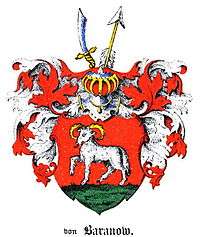Peter von Baranoff
Peter Paul Alexander von[1] Baranoff (Russian: Пётр Петро́вич Бара́нов, tr. Pyotr Petrovich Baranov; 9 May [O.S. 27 April] 1843 – 22 December 1924) was a Baltic German military officer and statesman. During the First World War, Baranoff was best known for his investigation works, most notably his investigation of fellow general Paul von Rennenkampf's actions during the Battle of Łódź.
Peter von Baranoff | |
|---|---|
 Lieutenant-General Baranoff in 17th century Russian court clothes during the 1903 Ball. | |
| Born | 9 May [O.S. 27 April] 1843 Reval, Harrien County, Governorate of Estonia, Russian Empire (in present-day Tallinn, Harju County, Estonia) |
| Died | 22 December 1924 (aged 81) Tallinn, Harju County, Estonia |
| Buried | Tallinn Alexander Nevsky cemetery (et) |
| Allegiance | |
| Service/ | |
| Years of service | 1861 – 1917 |
| Rank | |
| Commands held | 1st Sumy Hussar Regiment Her Majesty’s Ulan Guards Regiment 1st brigade, 2nd Guards Cavalry Division |
| Battles/wars | January Uprising Russo-Turkish War World War I |
| Children | 2 children |
Peter von Baranoff | |
|---|---|
| Coat of arms |  |
| Titles and styles
Herr von Baranoff | |
| Noble family | Baranoff |
Biography
Origin
Peter was born in 9 May [O.S. 27 April] 1843 in Reval in the Governorate of Estonia (present-day Tallinn, Estonia), to Peter Hermann von Baranoff and Marie Louise Simplicie Pauline von Nicolay (ru).[2]
Peter was from the Baltic German and Swedish noble Baranoff family (de) of Swedish and Russian descent. The Baranoffs was originally Russian boyar who entered Swedish service after Estonia was ceased to the Swedish under the conclusion of the Treaty of Teusina at the end of the Russo-Swedish War From 1590 to 1595. And many of them, quickly adapted to the Germanic traditions, converted to Lutheranism, and quickly became Baltic German subjects, including the Baranoffs, which was headed by four brothers: Voin, Fyodor, Kasyan and Menshik Baranov,[3] which they changed their surname from Baranov to Baranoff to be more better suited into German. The descendants of Voin and Fyodor quickly died out in the late-17th Century, while the descendants of Kasyan survived they died out in the late-19th Century, but the descendants of Menshik, which Peter was directly descended from, are still surviving til today.[4] The family was enrolled into Swedish nobility in 1666. In 1745, the Estonian high count gave an appeal the "Attestatum nobilitaris", that under the conclusion "that from 1592 on the Baranoff family was to be brought under local nobility". So the family was enrolled into the Estonian Knighthood that same year, the family was also enrolled into the Livonian and Oesel Knighthoods (de) following the years 1830 and 1843 simultaneously.[5]
Peter belonged to the Arroküll-Waetz branch,[6] a subdivided branch of the family founded by Peter's great-grandfather Peter Karl von Baranoff, who was married to Johanna Juliane von Hastfer (de). Some of the most famous members of the Baranoffs also belonged to this branch, including Peter's uncles Johann , Nikolai , Paul von Baranoff , who were all high-ranked Russian military officers and statesmans.
On his mother's side was the Nicolays, his mother's father was Paul von Nicolay , who was the son of the famous German poet Ludwig Heinrich von Nicolay, making Peter von Baranoff the great-grandson of him.
Honours and awards
Domestic




.svg.png)


.svg.png)




Foreign
.svg.png)




.svg.png)



Notes
Citations
- In German personal names, von is a preposition which approximately means of or from and usually denotes some sort of nobility. While von (always lower case) is part of the family name or territorial designation, not a first or middle name, if the noble is referred to by surname alone in English, use Schiller or Clausewitz or Goethe, not von Schiller, etc.
- Stackelberg, Otto Magnus v. Genealogical Handbook of the Estonian Knighthood, vol. 1. Görlitz (1931), pp. 33
- Stackelberg, Otto Magnus v. Genealogical Handbook of the Estonian Knighthood, vol. 1. Görlitz (1931), pp. 18
- Stackelberg, Otto Magnus v. Genealogical Handbook of the Estonian Knighthood, vol. 1. Görlitz (1931), pp. 25
- Stackelberg, Otto Magnus v. Genealogical Handbook of the Estonian Knighthood, vol. 1. Görlitz (1931), pp. 16-17
- Stackelberg, Otto Magnus v. Genealogical Handbook of the Estonian Knighthood, vol. 1. Görlitz (1931), pp. 29
- Stackelberg, Otto Magnus v. Genealogical Handbook of the Estonian Knighthood, vol. 1. Görlitz (1931), pp. 32
- ria1914.info
Sources
- Russian army in the Great War: Card file of the project: Baranov, Pyotr Petrovich
- Welding, Olaf. Baltic German Biographical Dictionary 1710-1960. (1970), from the Baltic Biographical Dictionary Digital
- Klingspor, Carl Arvid. Baltic heraldic coat of arms all, belonging to the knighthoods of Livonia, Estonia, Courland and Oesel noble families. Stockholm (1882)
- Stackelberg, Otto Magnus v. Genealogical Handbook of the Estonian Knighthood, Vol. 1. Görlitz (1931)